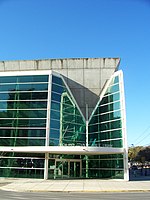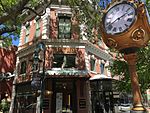House of Peace Synagogue
1907 establishments in South Carolina1915 establishments in South CarolinaAfrican-American history of South CarolinaAshkenazi Jewish culture in South CarolinaBuildings and structures in Columbia, South Carolina ... and 9 more
Former religious buildings and structures in South CarolinaFormer synagogues in the United StatesJewish organizations established in 1907National Register of Historic Places in Columbia, South CarolinaPolish-Jewish culture in the United StatesRussian-Jewish culture in the United StatesSynagogues completed in 1915Synagogues in South CarolinaSynagogues on the National Register of Historic Places in South Carolina

The House of Peace Synagogue is a former synagogue of the Beth Shalom Congregation in Columbia, South Carolina. It was originally located at 1318 Park Street. After the congregation moved in the 1935, the building was used for the Big Apple Club, which was an African-American night club. It was named to the National Register of Historic Places on August 28, 1979. In the early 1980s, the building was moved to its present location at the southeast corner of Hampton and Park Streets. In 1993, it was purchased by the Historic Columbia Foundation and is called the Big Apple.
Excerpt from the Wikipedia article House of Peace Synagogue (License: CC BY-SA 3.0, Authors, Images).House of Peace Synagogue
Hampton Street, Columbia Main Street District
Geographical coordinates (GPS) Address External links Nearby Places Show on map
Geographical coordinates (GPS)
| Latitude | Longitude |
|---|---|
| N 34.004166666667 ° | E -81.038333333333 ° |
Address
Big Apple
Hampton Street
29204 Columbia, Main Street District
South Carolina, United States
Open on Google Maps










